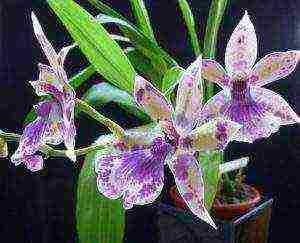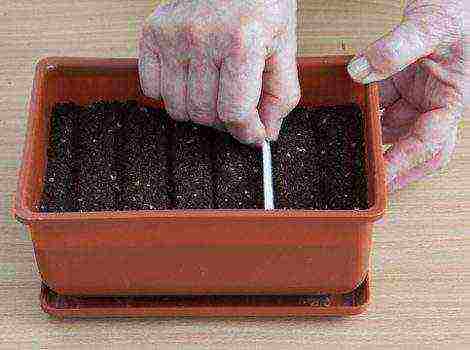Content
- 1 How to grow seedlings from saxifrage seeds
- 2 Planting and caring for young saxifrage shoots in the open field
- 3 The best ornamental plant varieties saxifrage
- 4 Diseases and pests of saxifrage in the open field
- 5 The best siderates for saxifrage flowers
- 6 Effective mineral dressings for saxifrage flowers
- 7 Recommendations for the use of saxifrage in landscaping
- 8 Frequently asked Questions
- 9 Sadovaya
- 10 Planting and leaving
- 11 Room
- 12 Growing
- 13 Flower propagation
- 14 Parasitic diseases
- 15 Saxifrage and zodiac signs
- 16 Saxifrage and feng shui
- 17 Conclusion
Saxifrage is a low-growing perennial herb that is grown as an annual plant in many regions. The saxifrage is known as "tear - grass". Under natural conditions, saxifrage prefers to grow in infertile rocky areas. Despite the fragile appearance of the plant, the roots of the saxifrage can destroy the rock. In the article we will tell you about growing saxifrage from seeds, when to plant, and give advice on care.

More than 400 species of saxifrage and more than 50 cultivated plant species grow in natural conditions.
The saxifrage blooms with a lush bright carpet. The cultivated species of saxifrage are characterized as frost-resistant plants and unpretentious to soil and maintenance. Depending on the species and variety, they are found with white, yellow, purple, red, pale pink inflorescences, which are collected in racemose or paniculate inflorescences. The flowers of most varieties are very small, located at the top of thin graceful stems.
Succulent leaves are located on numerous lateral branches, the color of the leaves is predominantly dark green. Saxifrage blooms for a little over a month. Depending on weather and growing conditions, the flowering period occurs between May and August.
Saxifrage is a godsend for amateur gardeners, since planting and growing it is not difficult. Saxifrage is grown as a houseplant, and gardeners prefer to grow it in rabatki, in curbs, in flower beds, and also used for stony-flower compositions and for decorating alpine hills. Read also the article: → "Alpine slide in the country."
How to grow seedlings from saxifrage seeds
From the seeds of saxifrage, seedlings are grown in greenhouses. The grown seedlings are planted in open ground in early July. Seedlings planted in open ground will begin to bloom only after a year. Consider the step-by-step instructions for the pre-sowing preparation of seeds and soil.
The optimal time for sowing saxifrage seeds is late March - early April.
Saxifrage seeds are very small, so before planting, the seeds should be mixed with clean sand, which will help to distribute the seeds evenly on the surface of the seedling box. Before you start sowing seeds, you need to perform several activities:
- Seed preparation. Before sowing seeds in planting containers, they should be stratified: the seeds are laid out in a small bowl and sprinkled with a thin layer of sand and sent to the refrigerator for 3 weeks. Saxifrage seeds are stratified to improve germination and accelerate germination
- Soil preparation for sowing stratified seeds in a seedling container: The germination of saxifrage seeds depends not only on stratification, but also on the water and air permeability of the soil. Seedlings are best planted in a biohumus soil substrate.
- Sowing seeds in a seedling container or in peat tablets. Read also the article: → "Review of the use of peat tablets for seedlings."Stratified seeds are evenly distributed together with sand over the surface of wet soil, or put 2-3 pieces in peat tablets, lightly sprayed with warm water. The container with seeds (peat tablets) is covered with foil and placed on the warmest and lightest window sill. As soon as shoots appear, the film is removed from the container. Seedlings will sprout in 10-15 days.
- Care. Watering is not required prior to emergence. The main care is to remove the accumulated condensation on the surface of the film.
- Picking. As soon as the seedlings have 2 leaves, they are dived into separate containers - pots, cups for the further development of roots and a larger area of nutrition.
- Preparing the substrate and planting young shoots in cups. For dived plants, a loose soil mixture is chosen, which is mixed with sand and peat in equal parts. The cups are filled with prepared soil by three quarters and lightly tamped. Then they form a depression in the soil with a finger and begin to transplant the seedlings. The saxifrage sprouts should be removed with a spoon together with an earthen clod. Before immersing the seedlings in the holes, it is recommended to shake off the lump of earth a little and pinch the longest root for the further development of the lateral roots.
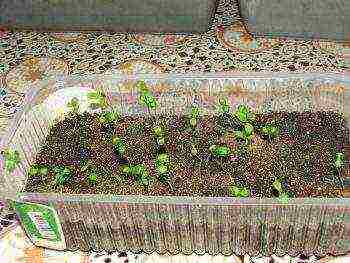
Growing saxifrage from seeds
- Care of dived saxifrage seedlings. After picking, the seedlings are watered in moderate quantities with warm water. Cups with seedlings are removed for 48 hours away from sunlight.
Tip # 1. It is known that saxifrage seedlings are very fragile, therefore, before diving for 2 hours, the soil in the planting containers should be well watered with warm water.
Planting and caring for young saxifrage shoots in the open field
Before planting seedlings, lime, gravel, sand and high moor peat should be added to the soil. Seedlings are planted in open ground using the transshipment method. Florists recommend not to water the seedlings in cups 2-3 days before transshipment, so that the earthen lump with seedlings can be easily removed. Seedlings are planted in moist soil.
Saxifrage seedlings are planted at a distance of no more than 20 cm, which will allow you to get a solid and dense floral carpet. Seedlings are planted only on the shady side of the site. Water the seedlings in the morning and evening hours as the soil dries up. Loosening and weeding is carried out as needed. Plants are fed once a month with strictly mineral fertilizers. Top dressing is applied along with water during irrigation.
In the table, we will consider the main types of mineral fertilizers, as well as the timing and rates of their application.
| Fertilizers | Application period | Application rate g / m2 | Basic substances |
| Potassium | Autumn before spring planting. Late spring and summer | 15-20 | Potassium sulfate and carbonate |
| Phosphorus | 30-40 | Superphosphate
Phosphoric flour |
|
| Nitrogen | Spring, autumn | 30-40 | Ammonium sulfate |
| 25-30 | Ammonium nitrate |
Tip # 2. After planting seedlings in open ground, the first feeding is done only after 3 weeks. In 3 weeks, young saxifrage shoots finally adapt to the soil.

Optimum temperature for saxifrage flowering 20 ° C
The best ornamental plant varieties saxifrage
Cultivated saxifrage varieties can improve the appearance of any area. Ideal for growing in flower beds, flowerpots, as well as for the decoration of organized flower beds and large stones. To grow saxifrage in the garden, varieties of Arends' soddy saxifrage are chosen. The best varieties of Arends' saxifrage include:
- Variety "Purplemontel" - the height of the plant does not exceed 20-25 cm. The flowers are medium, bright, with a purple-pink hue, forming a very dense green carpet. Blooms in early June. Variety "Purpurmontel" - not afraid of frost, when grown as a perennial plant does not require shelter.
- Variety "Snow carpet" - plant height does not exceed 15 cm. Flowers are medium, bright, white, forming a dense green carpet. Blooms in mid-May.The "Snow Carpet" variety forms a dense pillow up to 3-5 cm in height. Ideal for decorating rocky areas.
- Variety "Flora Carpet" - plant height no more than 20 cm. Flowers are medium, white-pink. It blooms beautifully on the alpine hills. Blooms in early June. The "Flora Carpet" variety forms a dense cushion up to 3-5 cm in height. The only variety that prefers to grow on the sunny side of the site
- Variety "Flamingo" - plant height no more than 20 cm. Flowers are medium, white-pink. They are planted in small groups on a personal plot and in flower beds. Blooms in early June.
Flamingo variety - most often grown as a perennial plant. Winter-resistant variety.
Diseases and pests of saxifrage in the open field
Saxifrage is the most resistant plant to diseases and pests, practically not affected by pests and diseases. With improper care, in rare cases, plants affect diseases such as septoria. You can save the plant from the disease with a weak solution of copper sulfate. As a preventive measure, conduct regular inspection of plantings and remove affected buds, as well as observe moderate watering.
From pests - green aphid. You need to fight the pest with Bordeaux liquid. As a preventive measure, carry out regular inspections, remove the affected leaves. In the table, we will consider the main reasons for the appearance of septoria and aphids on saxifrage plantings.
| Diseases / pests | Causes of occurrence | Amazes | Fungicides |
| Septoria | Thickened plantings, excess moisture. There are infected plants on the site. | Young sprouts | Bordeaux mixture, copper sulfate |
| Green aphid | A plant of any age |
The best siderates for saxifrage flowers
Siderata are unique crops that can improve the composition and structure of the soil mixture, as well as enrich the soil with useful substances. Consider several types of green manure:
- Phacelia. The main advantage of the plant is its rapid reproduction in a dedicated area, so the weeds do not have time to emerge and develop where the phacelia grows. Another advantage is its attractive appearance, which allows it to be planted with brightly flowering plants and even create compositions. Phacelia flowers of a gentle lilac shade are an excellent honey plant.
- Lupine - planted to enrich the soil with minerals. Differs in a dense green mass, early maturity, and most importantly - a high return of nutrients. Lupine brings nitrogen, phosphorus and potassium to the soil.
- Buckwheat. Buckwheat is grown to enrich poor, acidic and heavy soils. Buckwheat is considered a good supplier of mineral fertilizers such as phosphate and potassium to the soil. Buckwheat roots release acid, which breaks down difficultly soluble compounds and makes them available to other plants.
- Amaranth - improves the structure of the soil, makes it water and air permeable. The structure of the soil is improved by the roots that go deep into the soil. Amaranths are resistant to pests and diseases.

Saxifrage Arends Carpet
Effective mineral dressings for saxifrage flowers
Despite the unpretentiousness of saxifrage, gardeners recommend feeding three times a year with mineral fertilizers, especially those varieties that are grown as a perennial flower crop. The table shows the main types of baits and fertilization rates:
| Fertilizer name | Fertilization rate | Application period |
| Superphosphate | 5 g in each well | When planting seedlings in open ground |
| Nitroammofoska | 5 g for 1 liter of water | 2 weeks after planting and at the budding stage |
| Azofoska | 5 g for 1 liter of water | During the period of active growth of green mass of flowers |
Recommendations for the use of saxifrage in landscaping
Saxifrags are characterized as drought-resistant plants, therefore, for landscaping in a personal plot, saxifrage is planted in arid areas.Looks great and thrives on rocky areas, especially where unsightly areas should be covered. Read also the article: → "Small alpine slides are a great option for small areas."
Common mistakes when planting saxifrage
Experts identify several mistakes that gardeners often make when growing saxifrage:
- Grown in direct sunlight.
- Seedlings for seedlings are not stratified.
- The depth of planting seeds in the ground is more than 2 cm.
- Application of mineral fertilizers during flowering.

The saxifrage looks flawless on the alpine slides.
Frequently asked Questions
Question number 1.Can saxifrage be grown under trees or tall bushes?
Saxifragers prefer to grow on the shady side of the plot, so growing saxifrage is allowed under trees and shrubs.
Question number 2.How to prolong saxifrage bloom?
Regular inspection for faded flowers and their timely removal can extend flowering by 10-15 days.
Question number 3.How to protect saxifrage from green aphids without chemicals?
Plant greens at a distance of several meters - parsley and garlic, but it is better to sow buckwheat next to the saxifrage.
Question number 4.What plants should not be planted with saxifrage?
Saxifrage is an amazing plant that gets along well with any plants. However, wild-growing clover, which is often planted for landscaping the site, quickly spreads and is able to "strangle" young saxifrage seedlings.
Rate the quality of the article. We want to be better for you:
The modern urban flower lover has access to almost all the diversity of the world. It is surprising that with the modern development of garden and indoor culture, it is possible to see adapted plants from all over the world. One of these natural wonders is the saxifrage.
The saxifrage got its unique name because of its high adaptive qualities. It can grow both on ordinary soil and on mountain slopes.
Sadovaya
The saxifrage can be seen in modern gardens, in the "Alpine Hill" ensemble. It looks great between trees, like colored grass. For its cultivation, gardeners buy both a ready-made small-sized plant and use seeds. As mentioned above, saxifrage grows on different soil, but prefers light soil, regularly fertilized. It does not like excessive moisture, therefore it is very undesirable to plant it in a lowland, the roots can rot. The plant can survive severe frosts and high temperatures.
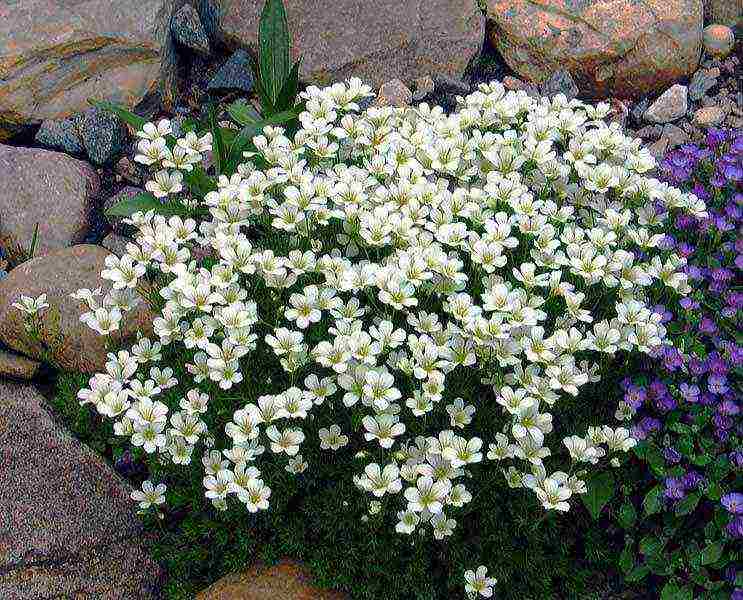
Saxifrage.
Saxifrage is planted and transplanted in autumn and spring.
Planting and leaving
The flower does not require increased attention to itself. But, the saxifrage needs to be replanted from time to time, as a rule, once every seven years. It certainly needs to be provided with sufficient watering. Also, it should, in a timely manner, fertilize with mineral compounds. Fertilizers proved to be excellent: "Kemiro Lux" and "Effekon". You can take another liquid mineral fertilizer. Also, perennial plants and trees should be carefully foliated before cold winters.
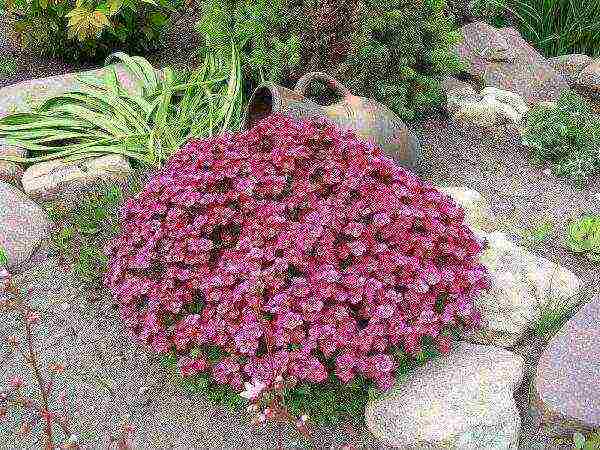
From time to time, it is necessary to engage in the formation of a saxifrage bush - for this, dead wood and unnecessarily long shoots are cut off. Plant rejuvenation is also carried out by dividing the bush and transplanting to another place.
Room
Recently, it has become popular to breed saxifrage at home as a houseplant. Domestic saxifrage differs from street culture in size.

For a room saxifrage is preferable, coolness than heat, absolutely not afraid of drafts, on the contrary, prefers a well-ventilated room. This plant should not be placed in direct sunlight. If the windows of a room or office face the south side, then the flower should be removed to the back of the room.Watering is regular, but the saxifrage should not experience excess moisture, since dampness can lead to decay of the root system and, as a result, plant disease. In spring and summer, it must be fertilized regularly with mineral mixtures. The main cause of illness at home is excess moisture.
Growing
Saxifrage blooms in late May - early June. Flowers are available in white, cream, yellow, bright red and pale pink shades. The flowers are combined into an inflorescence.
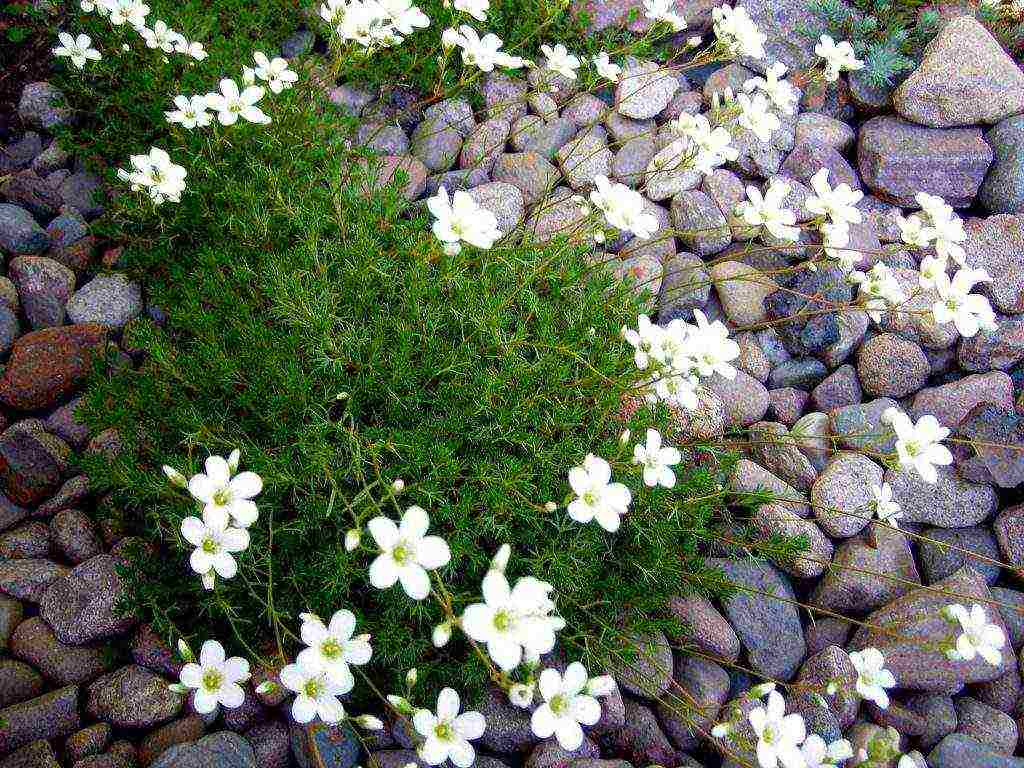
The saxifrage looks very interesting - a solid carpet of green leaves, and from above there are islands of amazing flowers. Saxifrags look great in recreation parks and squares.
Flower propagation
For reproduction, the method of cuttings is used, seeds are planted and an adult bush is planted.
The first method is quite simple and widespread. You can take almost any part of the bush, the only condition is the appearance of the cutting. Shoots are planted in the ground, pre-moistened, to a depth of three to four centimeters and create a greenhouse effect using cellophane film. Gardeners recommend replanting the plant in the spring.

You can plant an adult plant in different pots or in different parts of the garden; peat must be included in the soil mixture. Each individual bore must have a good root system.
With the help of seeds, saxifrage also reproduces well. But before planting the seeds, it is advisable to germinate them in light soil for reliability, this should be done no later than February. The seed pot is kept at 0 degrees for three weeks and creates a greenhouse effect. The main content of the pots is peat. The seeds are watered regularly. Saxifrage sprouted from seeds, usually blooms after a year.
Parasitic diseases
Sometimes, red spots appear on a room saxifrage, mealybugs are the culprits of this disease. It is possible to cope with them both with the help of chemicals that are sold in flower shops, and using folk remedies. Having made soapy foam, lathering with laundry soap and rinsing the leaves several times, you can brew tobacco and also wash the leaves and stems.
It happens that the flower begins to turn yellow, and the leaves fall off. The reason for this is the spider mite. In order to save the plant, you need to rinse it with purified water for several days in a row, if this does not help and the saxifrage flower continues to wither, then you need to buy insecticidal preparations.
Occasionally, the plant also suffers from fungal diseases, which can be dealt with with antifungal drugs.
Saxifrage and zodiac signs
Recently, it has become popular to check your designs and plans with astrological forecasts. Did you know that each astrological sign of the zodiac has its own stones, trees and flowers. For example, saxifrage corresponds to such zodiac signs as Libra and Aquarius. If this is your zodiac sign, then this flower will be easy and pleasant for you to grow.
Saxifrage and feng shui
The saxifrage has a wonderful energy that revolves in a spiral around the plant, capturing and concentrating qi in one place. The plant attracts love and good luck to the house, neutralizes negative emotions (fear, anger, greed, envy), and also normalizes, restores and harmonizes love and friendship. It tends to attract good people and valuable employees, attract successful projects, unite and unite teams. If there is a saxifrage in the office, employees become more proactive and persistent in achieving the goal. The flower will help unassembled people to concentrate on a specific matter, not to be scattered and to bring the started project to its logical conclusion. The saxifrage is placed in the wealth and career area. It improves the atmosphere in the house when placed in the family area. But you should remember your successes or failures, mutual understanding or lack thereof - primarily depend on your thoughts, actions and aspirations.
Conclusion
Saxifrage can be grown both in gardens and at home. She is quite unpretentious in care, and very decorates the space around her. It is also easy to breed it, it can be done using rosettes, cuttings and seeds.
Interesting to know! For medicinal purposes, almost all parts of the saxifrage are used - which is surprising in itself - the seeds, roots, leaves and sap of the plant. They are dried and frozen. The roots contain pectin, essential oil, tannins, coumarin, potassium, and the leaves contain vitamin C, protein and carotene. The sap of the plant promotes the healing of duodenal and stomach ulcers, helps in the treatment of otitis media and fever, and also to improve lactation. But nursing mothers should still consult a pediatrician first. Saxifrage has a beneficial effect on the kidneys. Helps with hypertension. Has anti-inflammatory properties.
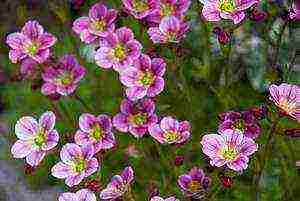 Saxifrage, a fairly common perennial flower that is often used as an ornamental plant to decorate garden and backyard plots. Since this herbaceous plant grows in its natural environment in the cracks of rocks, cliffs, it is customary to use it as a decoration for alpine slides and retaining walls. Therefore, saxifrage has become one of the most popular flowers, cultivation from the seeds of which, for further use in landscape compositions, is quite affordable at home.
Saxifrage, a fairly common perennial flower that is often used as an ornamental plant to decorate garden and backyard plots. Since this herbaceous plant grows in its natural environment in the cracks of rocks, cliffs, it is customary to use it as a decoration for alpine slides and retaining walls. Therefore, saxifrage has become one of the most popular flowers, cultivation from the seeds of which, for further use in landscape compositions, is quite affordable at home.
 The advantage of saxifrage is not only the attractive appearance of the flowering carpet. But also such features as compactness, frost resistance and durability. And after it fades, you can collect a lot of seeds, which will become planting material for further reproduction.
The advantage of saxifrage is not only the attractive appearance of the flowering carpet. But also such features as compactness, frost resistance and durability. And after it fades, you can collect a lot of seeds, which will become planting material for further reproduction.
The saxifrage family, to which this flower belongs, has more than 350 varieties found around the world. Both perennial and annual saxifrages belong to this type of plants, differing in the height of the stems and color of flowers, which can be white, pink and even red.
In general, saxifrage is a small bushy carpet, the leaves of which are collected in root rosettes and have a green color with a silvery tint. Saxifrage stems can grow up to 70 cm tall, depending on the plant variety. The flowers of this garden culture are five-petal with a diameter of up to 2 cm.
Saxifrage is a rather unique plant, because its cultivation at the initial stage involves the treatment of seeds with cold. It is this interesting feature that affects the germination of seedlings.
A short video instruction will acquaint you with some of the features of the plant and will help you get a general idea of the saxifrage for those who have not heard of it before.
>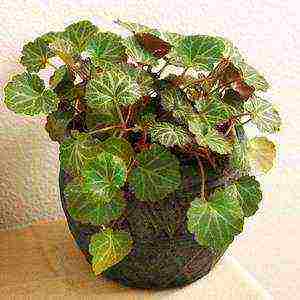 Sowing seeds at home can begin with the arrival of April. The purchased seeds are cold treated. This process consists in putting a little soil in a small container, preferably light and slightly moistened. The seeds are laid out on the soil surface, after which the container should be refrigerated for 2-3 weeks.
Sowing seeds at home can begin with the arrival of April. The purchased seeds are cold treated. This process consists in putting a little soil in a small container, preferably light and slightly moistened. The seeds are laid out on the soil surface, after which the container should be refrigerated for 2-3 weeks.
After the expiration date, the container with the seedlings is removed and placed on the windowsill of a light window. To create greenhouse conditions and in order to quickly germinate seeds, the container should be covered with plastic wrap. Further, it is worth maintaining the temperature for this mini-greenhouse in the range from 18 to 20 degrees. With proper observance of the processing time and temperature regime, the first shoots will appear in a week and will be the same as in the photo.
Further cultivation is to wait for the appearance of strong leaves of the plant and dive the seedlings into boxes with a large volume.
As a rule, the first leaves of saxifrage seedlings are very weak, so the picking process should be done after the second leaf appears.
Among experienced florists, one sign has taken root, which concerns the timing of seed germination. If the seedlings have not sprouted for 2 - 2.5 weeks, then, unfortunately, they will not germinate.
 Seedlings obtained from seeds can be planted in open areas at the beginning of summer. For saxifrage, medium fertile soil with good drainage will be excellent. Precisely because such plants do not tolerate stagnant moisture in the soil, they are grown on the slopes and in the crevices of stones. Seedlings are planted at a distance of 8-10 cm from each other, so that when the flower carpet grows, it seems solid.
Seedlings obtained from seeds can be planted in open areas at the beginning of summer. For saxifrage, medium fertile soil with good drainage will be excellent. Precisely because such plants do not tolerate stagnant moisture in the soil, they are grown on the slopes and in the crevices of stones. Seedlings are planted at a distance of 8-10 cm from each other, so that when the flower carpet grows, it seems solid.
When planting saxifrage seedlings, it is advisable not to remove the soil from the roots of the plant. If the capacity parameters of the mini-greenhouse allow, then you can try to cut the soil like a pie to divide them into shares. Subsequently, using a shovel, the lobes are planted along with a piece of earth.
The saxifrage will easily take root in the soil with a light composition. Even with the poor, one might say. This flower is not bad for the presence of limestone in the soil.
It is important to remember that water should not stagnate in the ground.
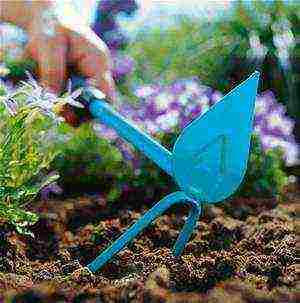 Further care is simple. In general, what will need to be provided for saxifrage flowers is:
Further care is simple. In general, what will need to be provided for saxifrage flowers is:
- Regular watering. The plant needs to provide moderate regular watering, but so that the soil has time to dry out. You should not allow the soil to flood so as not to harm the flower. The lack of watering can be noticed immediately by the state of the plant. In particular, the size of each flower will begin to decrease, and brown spots may appear on the leaves.
- Top dressing. Complex fertilizers are perfect for saxifrage. The first feeding can be carried out already 7 days after transplanting the seedlings to a permanent place in the garden.
- Loosening and weeding of the soil.
True, the flowering of saxifrage will come only after a year. However, if you plant the seedlings in a sunny place and do not provide good care in terms of watering, then the blooming carpet can become scarce and get "bald spots".
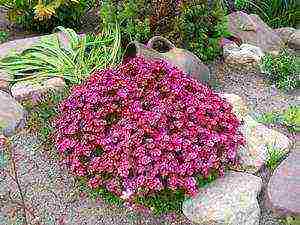 In general, each type of saxifrage requires special care. Wet soils are more suitable for some varieties, arid soils for others. In temperate natural conditions, the most common saxifrage Tenistaya (urban) and Arends.
In general, each type of saxifrage requires special care. Wet soils are more suitable for some varieties, arid soils for others. In temperate natural conditions, the most common saxifrage Tenistaya (urban) and Arends.
It is Arends' saxifrage that is most often found in gardens and has become an indispensable attribute of alpine slides. Perennial saxifrage Arends can grow both in partial shade and in open sunny areas. This type of plant pleases with flowering from the end of May to the beginning of June. Flowers of this species can be white, pink and purple, as shown in the photo.
In one place, Arends' saxifrage can grow for a rather long period, which can last up to several years. But nevertheless, the care of such a plant must be organized properly. And when the cushion of the bush begins to age and "fall apart", it is worth rejuvenating the plant.
As you can see, caring for a saxifrage does not require any special knowledge. And growing it can be a fun and exciting process for you.
Saxifrage (Latin Saxifraga) - a perennial plant, a one-year or two-year type of saxifrage is very rare.
The people call the saxifrage by another name - "Rip-grass", because it settles on a rocky surface, putting roots into existing cracks, destroying stones with them. It grows in the northern, arctic regions.
A low-growing plant spreads along the surface of the rocks. Saxifrage leaves can be of very different shapes, depending on its type. Most often they are round, slightly elongated, the texture is dense, fleshy. The leaves converge together into interesting, decorative rosettes. Their color also depends on the type of plant and ranges from green to gray, there are also variegated varieties, where several colors are included.
Saxifrage blooms in small racemose buds in the middle of the stem, the length of which does not exceed 0.5 meters. Flowers appear in early June and are pleasing to the eye all summer.
There are about 400 varieties. The most popular of them for breeding saxifrage at home are wicker saxifrage, paniculate, sinus-leaved, stiff-leaved, blunt-leaved, granular.
The saxifrage easily reproduces by pieces of the stem taken from the shoots. They can be immediately planted in the ground. Creeping lashes, which themselves have taken root in a pot, are also suitable for reproduction of saxifrage. They are carefully separated and used for planting.
When planting, the soil is made up of a mixture of sand and turf (1 part each) and humus (2 parts). During this period, the saxifrage needs abundant watering.
Please rate the article
Total voted 2. Rating out of 5

